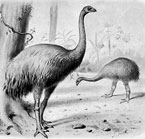Pre-Human New Zealand
Paleontology researchers from the University of Adelaide, University of Otago, and the NZDEC have begun to paint a picture of ancient life on the New Zealand islands by investigating the feces of the giant extinct moa bird. Some 1500 specimens of ancient feces, some multiple thousands of years old, have been found all over southern New Zealand, preserved beneath the floors of caves and rock shelters. The team of researchers has analyzed the samples’ (which are called coprolites) seeds, leaves, and DNA, gaining great insight into this forgotten world. It turns out that the Giant moa, which was up to 900 pounds and 10 feet tall, grazed primarily on tiny plants under a foot tall, dispelling previous thoughts of the birds as shrub and tree browsers. “New Zealand offers a unique chance to reconstruct how a ‘megafaunal ecosystem’ functioned,” according to Professor Alan Cooper, Director of the Australian center for Ancient DNA. “You can’t do this elsewhere in the world because the giant species became extinct too long ago, so you don’t get such a diverse record of species and habitats.” The findings of the study have been published in Quaternary Science Reviews.














